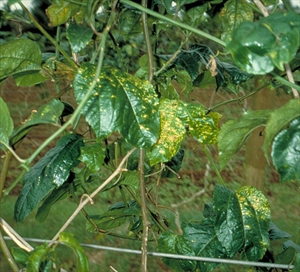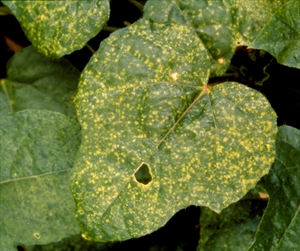Passionfruit woodiness
Pacific Pests, Pathogens, Weeds & Pesticides - Online edition
Pacific Pests, Pathogens, Weeds & Pesticides
Passionfruit woodiness (156)
Passionfruit woodiness potyvirus (PWV) and Cucumber mosaic cucumovirus (CMV). Both these viruses can cause woodiness symptoms alone, but often they occur together.
Passionfruit woodiness potyvirus and Cucumber mosaic cucumovirus have wide distributions, with CMV distributed worldwide. In Oceania, PWV is reported from Australia and Samoa, and CMV is reported from Australia, Cook Islands, Fiji, Federated States of Micronesia, French Polynesia, Guam, Kiribati, Nauru, Niue, Northern Mariana Islands, Palau, Papua New Guinea, Samoa, Solomon Islands, Tonga, and Vanuatu. The disease is reported from Fiji and Samoa.
Cultivated and wild species of passionfruit are hosts.
On the leaves, dark green patterns develop with light yellow spots (Photos 1&2). The leaves are often distorted, puckered and crinkled. The fruits are smaller than normal, deformed with thick skins and small centres containing the pulp (Photo 3). The symptoms are said to be worse in cool weather.
The viruses are spread by aphids (green flies). The aphids only need to feed for a short time on an infected leaf before they can spread the viruses to healthy plants. Aphids are not often seen on passionfruit. They land to feed, and then move through the crop. Pruning tools can also spread the viruses. The viruses are not spread through seed.
The viruses can cause a severe disease on passionfruit, but how severe depends on the variety and the types of viruses or their strains. Purple passionfruit (Passiflora edulis) and the yellow variety (Passiflora edulis flavicarpa) are susceptible, but some hybrids between them have tolerance. However, there are strains in Australia that produce severe leaf symptoms and woody, distorted fruit on the hybrids that are normally tolerant of the disease.
In Samoa, it is said that passionfruit commonly becomes infected and shows symptoms within the first 6 months from planting, but serious crop losses do not occur. This may be because temperatures are high throughout the year with little difference between the seasons. By contrast, in Fiji, the disease was the cause of the decline and eventual failure of the passionfruit industry in the 1980s.
Look for distorted leaves with green patterns and spots. Look for fruits that are smaller than normal and misshapen.
CULTURAL CONTROL
Cultural control is particularly important in the management of this disease:
- Selection: It is important to select planting material for propagation that is free from the disease.
- Rootstocks: Raise rootstocks from seed, and be careful that they do not become infected before they are grafted with scions.
- Site: Choose warmer, sheltered locations.
- Weeds: Remove weeds within and around plantations, especially wild Passiflora species. Note, CMV has a very large host range with several common crops that could be sources of infection: e.g., banana, capsicum, chilli, cucumber and other cucurbits, and tomato.
RESISTANT VARIETIES
Use tolerant hybrids, but note that there are strains that can overcome the tolerance. In Samoa, the yellow variety is reported to be relatively resistant to woodiness virus disease.
CHEMICAL CONTROL
Not appropriate for this disease. Although there are insecticides to kill aphids, they are not effective in stopping the spread of these kinds of viruses; this is because spread is so rapid. By the time the insecticide has killed the aphids, they have already fed and infected the plants with the virus(es).
AUTHOR Grahame Jackson
Information from (and Photo 2) Gerlach WWP (1988) Plant diseases of Western Samoa. Samoan German Crop Protection Project, Deutsche Gesellschaft für Technische Zusammenarbeit (GTZ) Gmbh, Germany; and from (including Photo 3) Diseases of fruit crops in Australia (2009). Editors, Tony Cooke, et al. CSIRO Publishing.
Produced with support from the Australian Centre for International Agricultural Research under project PC/2010/090: Strengthening integrated crop management research in the Pacific Islands in support of sustainable intensification of high-value crop production, implemented by the University of Queensland and the Secretariat of the Pacific Community.






